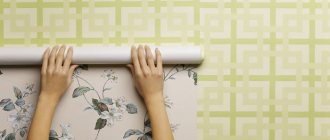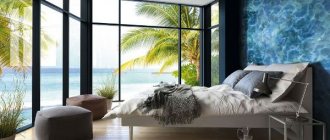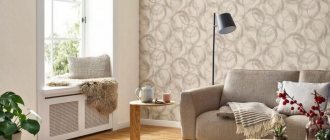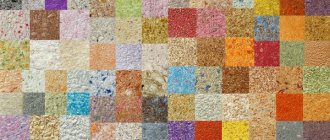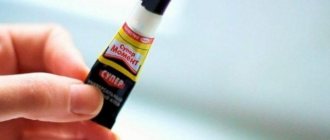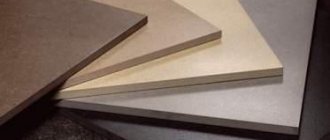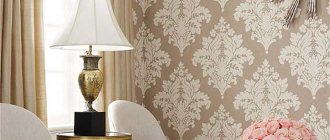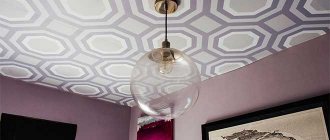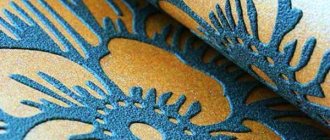Wall coverings can be very different and if you do not take expensive materials, you need to highlight five main types of wall coverings used for walls, in particular, such as wallpaper, liquid wallpaper, modern plaster, wall painting, flock coating.
Any decorative covering is an excellent alternative to conventional wallpaper, especially since there are more interesting and environmentally friendly safe materials, so they can be used for any room without exception.
- A worthy alternative to wallpaper for walls
- Decorative panels on the wall instead of wallpaper
- Fabric on the walls instead of wallpaper: modern materials
- Original cork backing for the wall instead of wallpaper
- How can you decorate a corridor instead of wallpaper to create an exquisite design in an apartment?
- Wall finishing options (video)
- Wall coverings in the interior (photo)
Finishing with traditional plaster
Plaster is the second most popular material for wall decoration after wallpaper. There are several types of this building mixture: textured - with the help of various tools a coating with a pronounced relief is created on the wall, structural - the coating acquires relief due to the composition of the mixture itself, mosaic and mineral - contain inclusions of resin, mica or stone chips.
Decorating a space using decorative plaster
Advantages of finishing walls with traditional plaster:
- the plaster is resistant to temperature changes and humidity fluctuations;
- vapor permeability - allows the walls to “breathe”;
- large selection of colors and shades, the ability to create relief;
- ease of application;
- relatively low price.
Disadvantages of finishing walls with traditional plaster:
- inaccurate adherence to technology leads to cracks and detachments of the plaster;
- cannot be applied to metal surfaces.
How to choose what to replace wallpaper on the walls with
When choosing the type of wall decoration in a house or apartment, it is important to consider several criteria. They will help you find the right material based on appearance and quality characteristics. In addition, if you make a responsible choice, you can prevent problems associated with irrational spending. It is recommended to consider the following points:
- Quality of material. Finishing must comply with existing norms and standards.
- Ecological cleanliness. The health safety of people living in the house depends on this.
- Possibility of causing an allergic reaction. It is worth checking the composition for the presence of hazardous substances.
- Features of application. Some types of finishes can be particularly difficult to install and require the use of additional materials.
- Price. Based on this criterion, you can choose a suitable finish according to your budget. It should be understood that low cost does not always mean poor quality, and vice versa.
It is also recommended to pay attention to the compliance of the selected material with the existing design project. Some types of finishes may only harmonize with certain interior styles. This takes into account colors, shapes, patterns and textures.
Venetian plaster finishing
Venetian plaster looks incredibly noble and aesthetically pleasing. Outwardly, it resembles marble with tints, smooth transitions or, conversely, with contrasting veins on a neutral background. A unique property of Venetian plaster is the visual effect of glow, as if emanating from the walls.
Wall decoration with Venetian plaster
Advantages of finishing walls with Venetian plaster:
- magnificent appearance;
- wide palette of shades;
- Venetian plaster, treated with special wax, is not afraid of changes in humidity and temperature fluctuations;
- the mixture can be applied to walls with minor defects;
- Partial restoration of the coating is possible.
Disadvantages of finishing walls with Venetian plaster:
- a rather complex preparatory process before applying Venetian plaster;
- relatively expensive type of finishing material.
How can you decorate a corridor instead of wallpaper to create an exquisite design in an apartment?
Many people are interested in what can be used to replace wallpaper when decorating a corridor to make it look more spacious and interesting. When decorating a corridor, you need to correctly select the shade and texture of materials.
To make the room more spacious, you need to select lighter shades of finishing materials, however, it is best to use warm colors, because otherwise the room will seem cold and uncomfortable.
When selecting finishing materials for the corridor, you need to use durable and stable finishing materials that can be cleaned without any problems. This is very important, because it is in the corridor that the largest amount of pollution from the street accumulates.
Wall panels are perfect for decorating a corridor; they look quite elegant and unique. Provided they are placed horizontally, you can achieve a visual enlargement of the room.
An environmentally friendly and natural material is beautiful decorative plaster, which has a wide range of colors to create an imitation of various structures. This coating is resistant to aggressive substances and mechanical damage.
Silk plaster finishing
Silk plaster is also known as “liquid wallpaper” and “wet silk”. Externally, this type of coating is similar to satin fabric that is applied to the walls. The glossy finish of silk plaster is achieved by adding silk and cellulose fibers to the mixture.
Silk plaster or “liquid wallpaper”
Advantages of finishing walls with silk plaster:
- ease of application;
- large selection of colors and shades;
- it is easy to repair a damaged wall fragment;
- vapor permeability - allows the walls to “breathe”.
Disadvantages of finishing walls with silk plaster:
- absorbs all odors (especially strong odors of food and cigarette smoke);
- fragility;
- Without a protective coating, it is afraid of moisture.
Options for original and unusual finishes
Ideas for what else you can do with walls instead of wallpaper:
- Paint the walls with decorative paint. It has no odor and is very easy to work with. If you want to get matte, glossy, textured or mosaic walls, then you should try a similar finishing method.
- Use bamboo sheets. This is a fairly quick way that will help you create an unusual and creative design in a room. Like fabric, bamboo sheets muffle sounds and also do not have a specific odor.
- Cover the walls with flock technique. It is necessary to apply an adhesive solution and glue special panels in the form of flakes. The final version looks like walls painted with acrylic paint.
The problem of what to replace wallpaper with is especially pressing today. The era of wallpaper is gradually becoming a thing of the past, as this method is becoming a rather boring way to decorate walls.
Moreover, they are often expensive in terms of money, and besides, the service life of wallpaper cannot be called long. But there are other options for wall decoration that will help refresh the interior and save money.
Painting with mosaic paint
Mosaic paint is a mixture based on acrylic copolymer and multicolor microgranules. These tiny capsules burst when they hit the wall and form unusual colorful spots on the surface. Mosaic paint should not be mixed before use. The material is applied to the walls using a spray gun.
Mosaic paint instead of wallpaper
Advantages of mosaic paint:
- original appearance of the finished coating;
- mosaic paint is resistant to temperature changes and humidity fluctuations;
- dirt can be easily removed from the surface of walls painted with mosaic paint;
- durability;
- vapor permeability – the wall “breathes” under a layer of paint;
- environmental friendliness.
Disadvantages of mosaic paint:
- limited selection of colors (within one brand or collection).
DIY wall decoration
The choice of material is largely determined by who will be doing the repairs. Complex types of installation and drawing up estimates are usually entrusted to craftsmen who have experience and specialized tools.
When installing finishing materials for wall decoration yourself, it is important to know the installation features. Wild stone can be distinguished in silicone or polyurethane forms by preparing the composition in the required proportion. All recommendations for applying topcoats must be indicated in the technical description.
When installing finishing materials for wall decoration yourself, it is important to know the installation features.
A smooth surface is needed for most types of interior decor. Blocks that are attached to the sheathing can also be used to hide wall defects. Wood regulates moisture well, but to operate it you need a machine and all the necessary tools. It is better to first familiarize yourself with the technology of laying any material using video tutorials.
Painting with textured paint
Textured paint is similar to textured plaster, because the creation of patterns and relief on the wall surface is achieved due to the composition of the paint. The material itself is dense, with a very viscous consistency. But unlike textured plaster, the paint is applied in a thinner layer.
Textured wall decoration
Advantages of textured paint:
- high moisture resistance: this material can even be used in the bathroom;
- textured paint does not absorb foreign odors and is not afraid of fungus and mold;
- hypoallergenic;
- withstands temperature fluctuations and does not fade in the sun;
- excellent vapor permeability;
- textured paint can mask minor wall defects.
Disadvantages of textured paint:
- difficulty in applying without professional training;
- A high-quality result is only possible after good surface preparation before application.
Summarize
Thus, in addition to the usual paper wallpaper, many options are used in wall decoration. Materials can be artificial or natural. The main thing is to choose environmentally friendly ones that do not cause allergic reactions and do not emit harmful toxic substances. It is also important to understand how easy a particular type of finish is to apply. For example, textured paint, decorative plaster, brick and fabric panels do not require special skills and abilities. But when working with porcelain stoneware and glass slabs, you need to have experience and a certain set of tools.
Wall frescoes on a backing
Fresco in the traditional sense is painting on wet plaster. However, there are many variations on this theme in the construction world. The most popular are frescoes on canvas and non-woven fabric, transfers and self-adhesive frescoes.
Fresco instead of wallpaper: interesting solutions
Advantages of wall frescoes on a substrate:
- high quality photo printing allows you to get an excellent image that is not inferior to traditional frescoes;
- You can order a fresco with an individual image;
- The flexibility of the material allows you to mount frescoes on any surface.
Disadvantages of wall frescoes on a substrate:
- Over time, the image may crack;
- frescoes require careful care.
Natural wood panels
Wood panels are another wall covering instead of wallpaper that will look very expensive and modern. It is customary to decorate the hallway, corridors, dining room or living room with this material.
Wood paneling boasts many beautiful options. If desired, you can decorate the walls of the rooms with spruce, pine, oak, aspen, etc. The material must be glued to the surface in a certain sequence to create a Scandinavian design or loft style in the house.
Designers advise sticking wood panels on only one or two walls in the room, and decorating other surfaces in lighter colors using plaster or fabric panels.
Wood in the rooms looks modern and expensive
Flexible sandstone finish
Flexible sandstone is made using the imprint principle: grains of sand are glued onto fabric using acrylic glue, recreating the pattern of the natural material. It is produced in two varieties: sheets and rolls. Impressions on flexible sandstone are always different: some are darker, others are lighter, in some there are more veins, and in others there are practically none.
Using flexible sandstone on walls
Advantages of wall finishing with flexible sandstone:
- long service life;
- environmental friendliness;
- aesthetic appeal;
- flexible sandstone is resistant to changes in humidity and temperature;
- Quite simple installation.
Disadvantages of wall finishing with flexible sandstone:
- high price.
Decorative brick
Decorative bricks for wall decoration can be made from gypsum, quartz, concrete, and ceramics. Depending on the type of material, such finishing may have the following advantages:
- Durability. To extend the service life, it is better to choose porcelain stoneware bricks.
- Safety. In terms of ecology, all materials are considered natural and harmless.
- Easy to install. Any person can cope with this task, even without experience in such work.
- Low price. In order not to spend a large sum on the purchase of brick panels, you need to give preference to gypsum options.
It is not recommended to cover all the walls in the room with decorative bricks. It is enough to highlight one part or a specific zone.
Flexible slate finish
Flexible slate is an ultra-thin layer of natural slate, which is applied to a polymer base using glue. Sheets of this material have unique patterns and textures, because in nature you cannot find two identical stones. Slate for walls, for all its flexibility, is highly durable.
Flexible slate in the interior
Advantages of wall finishing with flexible slate:
- slate is not afraid of exposure to high temperatures and changes in humidity;
- slate sheets are easy to cut and mount on the wall;
- environmental friendliness;
- excellent appearance;
- durability;
- Wide range of applications: flexible slate is suitable not only for walls, but also for cladding various surfaces, countertops, and kitchen aprons.
Disadvantages of wall finishing with flexible slate:
- high price;
- due to the nature of the natural pattern of the stone, it is impossible to lay it without seams;
- limited flexibility.
Porcelain tile wall slabs
A popular type of interior wall decoration recently are porcelain tiles. In their manufacture, various types of heat treatment are used, so the finished material can have several surface options. These include the following types:
- Matte. Such slabs do not have shine or smoothness. They have low cost and high resistance to various damages.
- Polished. Such slabs are slippery and shiny. They look very impressive, but have a drawback - they are easy to damage and scratch.
- Semi-matte. They differ in the presence of relief. The choice of textures is huge - and here you should rely on personal preferences.
There are also textured slabs. They can imitate the surface of real stones, granite, and wood. These are the most durable and long lasting options.
Textile finishing
There are two ways to decorate walls with textiles. In the first case, the material is glued directly to a previously prepared wall. In the second case, a frame is created from slats, onto which the fabric is secured using a stapler. Most often, the slatted method is used to decorate walls, but one must take into account the fact that a void is formed between the wall and the textile. Therefore, if you are going to hang pictures or shelves, the area under the fabric must be reinforced with wood panels.
Unusual options for using textiles in the interior
Advantages of wall decoration with textiles:
- no seams, unlike wallpaper;
- a synthetic padding layer between the fabric and the wall will improve sound insulation;
- the slatted method of finishing with fabric hides uneven walls;
- textile finishing looks very attractive.
Disadvantages of wall decoration with textiles:
- the fabric absorbs moisture, odors and dust without additional processing;
- high-quality installation is impossible without preliminary preparation;
- textiles can be easily flammable.
Popular types of finishing
Most often, wallpaper and paint are chosen for wall decoration; The next most common material is plaster. Each of these materials includes several subspecies, differing in composition, cost and produced results. But this is not the entire list of possibilities. You can decorate your walls beautifully and on a budget in other ways.
Combination of different textures Source modernplace.ru
Wallpapering
A traditional way of decorating walls, which, thanks to the amazing variety of materials, can add zest to any interior. There are several types of products, each with its own set of properties and limitations. Therefore, wallpaper is chosen based on its appearance. The following types of wallpaper are on sale:
- Paper. The most affordable and environmentally friendly, suitable for a children's room. They can be single- or multi-layer; thin wallpaper is suitable for smooth walls; in other cases, thick paper is preferable. Gluing is quite long and difficult; after drying, shrinkage is possible. Another disadvantage is the limited choice of colors, which is why you often have to refuse them.
Interior with two types of wallpaper Source roomester.ru
- Vinyl. The main quality of embossed vinyl wallpaper is moisture resistance. They can easily withstand washing with household chemicals, which is why they are often chosen for kitchen decoration. Additional advantages of this option for decorating a room are that vinyl does not absorb odors, and its choice is huge. When gluing, it is important to follow the technology, otherwise delamination is possible.
- Non-woven. Strong and durable wallpaper consists of 70% cellulose fiber; There are options for painting. Unlike vinyl, they allow air to pass through, fit well, glue quickly and do not shrink after drying. The disadvantage is the limited range of non-woven products, as well as the insufficient environmental friendliness of some products.
Wallpaper on an accent wall Source wp.com
- Fiberglass. Wallpaper is designed for a long service life and repeated staining. The materials are varied in texture, environmentally friendly and are not afraid of wet cleaning. The disadvantages include the higher cost of the wallpaper, glue and paint. For coloring you need a special dye, and its consumption will be large.
The following types of wallpaper cannot be classified as budget finishes. But to save on renovations, you don’t have to cover the entire room with them. The best solution would be to combine them with regular paper wallpaper.
Wallpaper in the kitchen Source prostroyer.ru
If you choose the right palette and texture, the room will take on a stylish and impressive look. The following materials can be used for emphasis:
- Natural. Modern wall finishing options include natural wallpaper. The products are environmentally friendly and contain no artificial dyes. The materials used are bamboo, jute (mat), straw, seaweed, and rice paper. Natural wallpaper is able to let air pass through itself (breathe); in the interior they create such a valuable feeling of closeness to nature. Care involves removing dust with a soft cloth.
- Textile. Fabric wallpaper is an expensive finishing method; their choice is justified if you rely on style and exclusivity of the interior. The technique of pasting fabric wallpaper is quite complex and time-consuming. Such work is entrusted to professionals, which means additional costs for paying for their labor.
Combining wallpaper is a fashion trend Source i5.walmartimages.com
- Wallpaper with silk-screen printing. Vinyl wallpaper undergoes special treatment, after which its front side becomes smooth, like natural silk. On the walls, this decoration looks very beautiful, but only if the gluing was done by a professional, and there is not a single wrinkle on the walls.
- Cork. You can create an unusual wall decoration if you take cork as a basis, which is available in three versions: in the form of rolled wallpaper, plates and paper-based cork. Pasting requires adherence to technology and professional experience. Finishing with cork increases sound insulation, the material is safe for health.
Cork cladding - environmentally friendly and beautiful Source r4.mt.ru
See also: Catalog of companies that specialize in interior redevelopment
- With imitation leather. Expensive embossed wallpaper imitates the skin of a snake, leopard, zebra, and crocodile. They are durable, look good in interiors with a strong personality: loft, modern, minimalism. The material is resistant to abrasion and can be washed, but in order to correctly fit the exquisite finish into the interior, you will need the help of a professional designer.
Among the considered wall decoration options, the most budget-friendly may be textured paper wallpaper, plain or with a small print. A small pattern is more profitable. The larger the print, the more you need to move adjacent canvases when gluing, and the more rolls you will need to purchase.
If you want to decorate a fragment of a wall or a niche with expensive wallpaper, a suitable piece can be found in a specialized store among the remnants. Discounts on such incomplete rolls can reach 70-80%.
Paper wallpaper in a vintage interior Source kraski-net.ru
Liquid wallpaper
This is the name given to a decorative finishing coating that is used for finishing walls and ceilings. In structure, it is not at all similar to the usual material and has the following parameters:
- Sold in the form of a dry mixture and is an environmentally friendly product. The composition includes cellulose and decorative fillers, such as viscose or cotton fibers. When dry, it resembles cotton wool interspersed with decorative elements.
Liquid wallpaper Source d1gc6ba1r4599p.cloudfront.net
- Before application, the mixture is diluted with water in the required proportion and applied to the wall using a plastic spatula. After drying, the result is a smooth, pleasant-to-touch surface with the selected texture.
- In terms of its texture, the material is related to plaster; not everyone knows that its official name is Danish decorative plaster.
- The material can be used for designer wall decoration. By laying it in layers, you get the effect of a natural (for example, marble) coating.
In Scandinavian style Source image.architonic.com
- The advantage of the application is that you do not need to prepare the wall; The thickness of the layer (5 mm) will reliably hide all irregularities and defects. The surface is smooth, without joints or seams.
- The service life of liquid wallpaper is approximately 10-12 years, which is comparable to paper wallpaper, but they are more expensive. The disadvantage is compensated by easy correction of damage. If scratches appear on the surface, the problem area is simply moistened with water, leveled with a spatula and allowed to dry.
Fragment of facing with liquid wallpaper Source foradesign.ru
Photo wallpaper
The fashion for photo wallpapers appeared in the 70s of the last century, but quickly faded away. Thanks to modern technologies, the idea of decorating walls with photo wallpaper has become popular again. This finish is used in different interior styles and for different rooms. There are the following types of it:
- Paper photo wallpaper. The most budget option, it is produced in two types: simplex (one layer) and duplex (two layers). Duplex gives better results; It has a minimal chance of image deformation when gluing.
Photo wallpaper in the kitchen Source m1.lmcdn.fr
Laminate for wall cladding
Finishing walls with laminate is a new way of cladding. For many, the unusual vertical laying of the material allows them to create an exquisite interior in the house, while maintaining the comfort and warmth of home in the room.
More often than not, laminate is used to decorate not the entire wall, but individual fragments, for example, areas at the head of the bed in the bedroom, the space behind the TV in the living room. This material can be used to decorate a children's corner or visually divide functional areas in a studio apartment.
A worthy alternative to wallpaper for walls: decorative panels
Decorative wall panels really are a good alternative to outdated wallpaper. The type of panels can be as different as you can imagine, and accordingly the price will also be different. The advantages of the panels are that they are not very difficult to install, in a short period of time you can finish a fairly large area, all the imperfections of the walls will be hidden under the material, the room will immediately take on an expensive look.
Wall panels are divided into:
- Tiled;
- Leafy;
- Rack and pinion.
All of these types are attached in the same way, so if you have already dealt with decorating walls with this material, you don’t have to worry about anything, because you already know what would be best to do when decorating the area to be treated.
The material from which the panels are made can be very diverse:
- Natural wood;
- Chipboard (chipboard);
- Fiberboard (wood fiber types);
- MDF panels;
- Durable glass;
- Gypsum vinyl;
- 3D panels;
- PVC;
- Plastic.
All these types of panels can have completely different characteristics, width, thickness and length, as well as a specific purpose. It is advisable to check all information from reliable sources or directly from the seller of these materials.
Covering walls with fabric
We continue to figure out how to decorate the walls in the apartment other than wallpaper. A good solution is natural fabric used to cover the surface. The advantage lies in the unity of the design style, because window curtains are made of a similar material.
Having decided what you can use to cover the walls in a country-style kitchen, focus on the fabric, decorating the apron of the work area with it and varnishing it as an additional protection to protect it from exposure to a humid environment. Curtains, tablecloths, napkins and chair covers are made from similar material. In general, everything looks stylish.
An alternative to wallpaper in the design of an apartment made of fabric material implies the presence of special skills in decorating, which are best entrusted to experienced craftsmen.
Before finishing the surface with fabric, the walls are pre-prepared and existing defective areas are repaired.
Fabric finishing is not done on all walls, but on a certain area.
How to stick
Pasting vinyl stickers is not difficult, but you must follow certain rules. Firstly, the room must be warm. Temperature not lower than +15°C. Secondly, humidity is normal, walls or any other surface must be dry and clean. There should be no dust, no grease, no dirt. If possible, the area under the sticker should be treated with a degreaser (solvent).
How to apply vinyl stickers to a wall - step by step photos
To work, you will need a small plastic spatula, which can be successfully replaced with an old plastic bank card. If you don't like working with plastic, try a dry, clean, soft cloth. These devices will help expel air bubbles from under the film.
We glue a large picture from vinyl film
The area for work has been prepared, the next procedure is as follows:
- Let's take the sticker apart and see how it will look. Very often it is a set of fragments. We take fragments and assemble them into a picture. We fasten them with pins or stationery tape in the intended place. Let's go away and take a look. If you are happy with everything, let's start gluing.
- You should start from the bottom and move up. First, the central fragment is glued, and the others are joined to it. So it turns out that you will have to move in two directions - from bottom to top and from the center to the edges.
At first it’s not clear what and how - From the bottom of the fragment we peel off a small section of the backing that protects the adhesive layer. Apply to the work surface. We try to glue it evenly, but if it doesn’t work, it’s okay - peel it off and try again. After the “start” has been glued correctly, we take plastic or a rag. Peel it off, folding a small part of the protective paper and gluing the strip. Peel off the protective paper again and stick it on. Moving up and to the sides we glue the entire fragment.
When sticking, do not remove the protective film from the front part - We looked, the fragment was glued evenly, everything was fine. Remove the protective film from the front part.
- We repeat the operation with the next piece of the picture. But now we still need to join the parts. The slightest discrepancy will be visible, so don't rush. We glued it, checked it, and removed the protective layer from the front part.
- We glue all the parts in the same way.
That's all. A few notes on the process. It is important to try to expel the air from under the vinyl film. Therefore, we move slowly, without allowing any omissions. Then there will be no bubbles. If the peel-off backing is in the way, it can be cut off.
We remove the film that is pasted on the front side after the fragment is completely pasted and all the air is removed. At the same time, you cannot leave it on the part when the next one is glued - the seam will be visible.
Features of a small picture
Above we described the process of gluing a large picture, consisting of several pieces that need to be joined to each other. But such complications are not always necessary. Some images are a set of elements that can be arranged relative to each other in any order. Such elements are usually glued on one sheet. They just need to be removed from the backing and pasted on the wall.
It’s easier to glue small fragments: popular butterflies and cartoon characters (Kitty)
But even in this case, in order not to make a mistake and not to re-glue the fragments from place to place, cut them out together with the backing. It is not necessary to strictly follow the contour; you can capture free areas of the substrate. Now distribute these pieces over the surface as you imagine, using pieces of masking tape. Evaluate the result. You may have to move something somewhere, change places. When you are satisfied with the result, start gluing.

